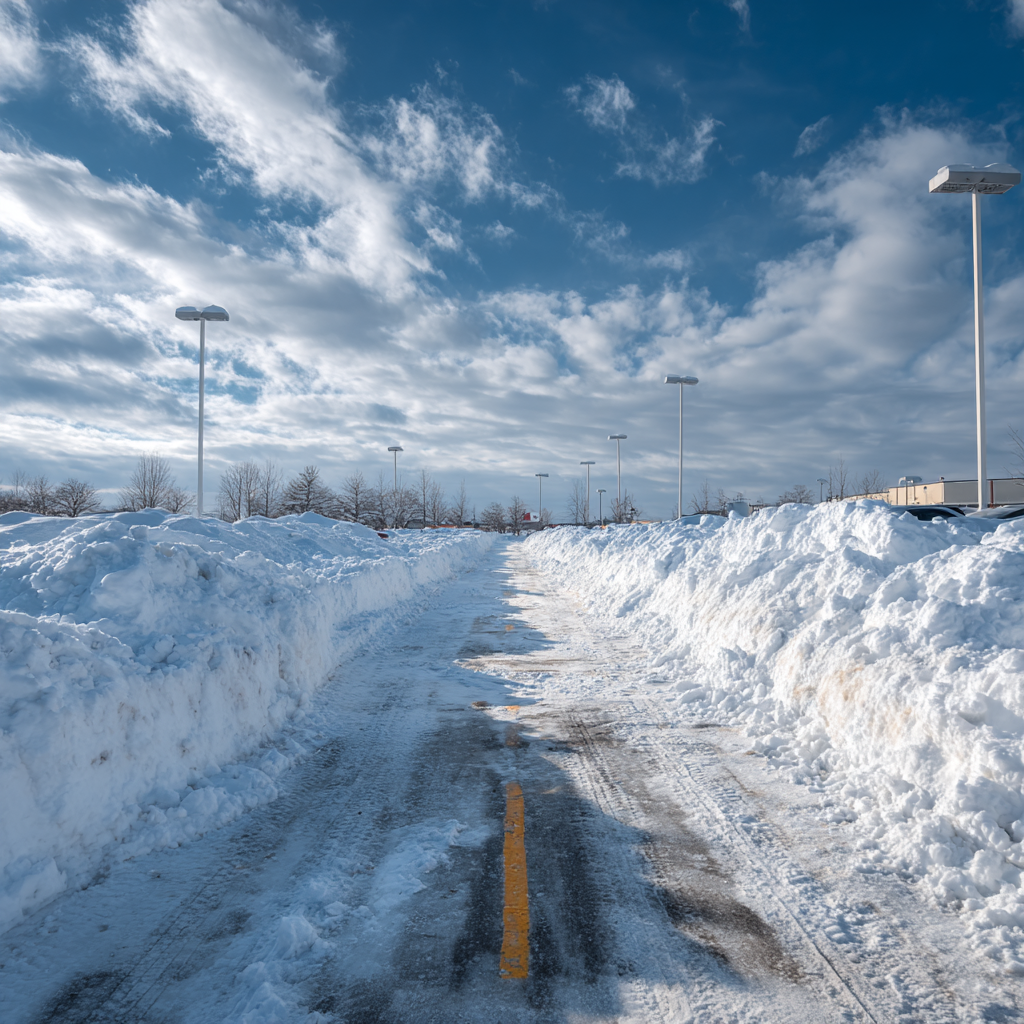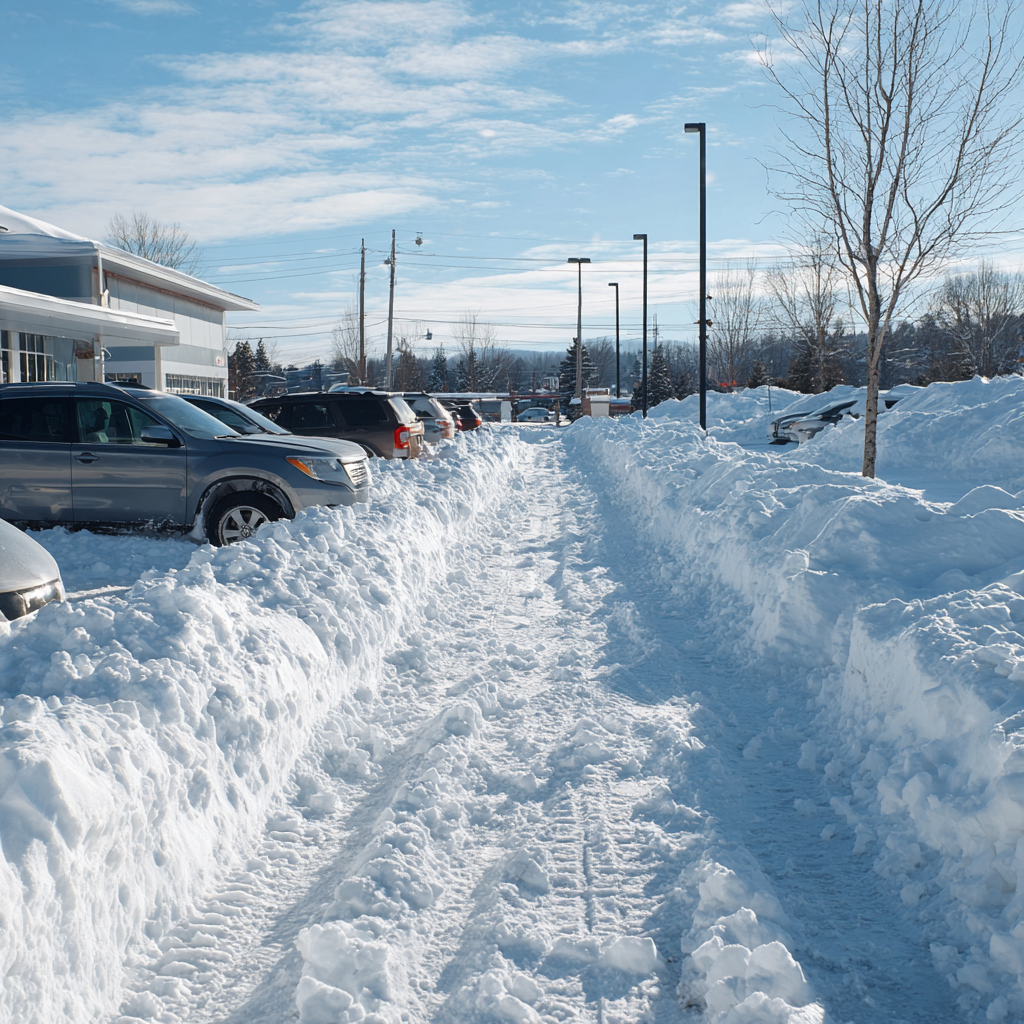Snow Removal for Large Properties in Minnetonka: Key Considerations
The Stakes for Large Properties

Managing snow removal for a large property in Minnetonka is not just about keeping pavement clear. It is about protecting people, property, and reputation. A well-maintained site communicates professionalism and care. An icy parking lot or blocked entrance does the opposite. For businesses, senior living facilities, or retail centers, unsafe conditions can quickly turn into liability issues that damage credibility with customers and tenants.
Large properties face unique challenges because of their scale. A two-inch snowfall may take one contractor an hour to clear from a residential driveway, but it can take several coordinated crews with multiple machines to fully service a business campus. The logistics are more complex: traffic patterns must be considered, snow piles must be planned so they do not block visibility, and timing must be precise to ensure lots and sidewalks are clear when employees, tenants, or customers arrive.
Minnetonka’s geography creates additional complexity. Properties near the lakefront face drifting snow and icy conditions from increased moisture in the air. Retail centers draw heavy traffic that requires frequent touch-ups. Multi-use properties must balance pedestrian safety with vehicle flow. These factors make it critical to hire a snow removal partner who not only has the right equipment but also the operational discipline to manage large-scale service.
The difference between an average contractor and a reliable one shows up in how smoothly your property runs during the harshest weeks of winter. Smooth operations reduce tenant complaints, prevent accidents, and allow property managers to focus on their work instead of dealing with emergencies.
Pro Tip: Snow removal for large properties is as much about planning as it is about plowing. Ask potential contractors how they manage logistics across big sites.

Equipment Matters: Right Machines for the Right Job
Not every contractor is equipped to handle a large property. A pickup truck with a plow blade may be fine for residential work, but it cannot keep up with the demands of a corporate campus or retail center. The key is having the right equipment for the right job.
For wide open spaces like parking lots, heavy-duty plow trucks and loaders are essential. They move large volumes of snow quickly and efficiently. For tight spaces—such as walkways, loading docks, and narrow drive lanes—smaller machines like skid steers and bobcats are indispensable. They allow crews to maneuver where larger equipment cannot go. Professional companies maintain a fleet that includes both, ensuring every part of a property is addressed.
Equipment is only part of the equation. Maintenance and backup capacity matter just as much. A plow truck that breaks down mid-storm without backup can leave a property unsafe for hours. Professional snow companies plan for this by maintaining their machines and keeping spare equipment available. That preparation makes the difference when storms hit back-to-back.
Minnetonka properties often need both approaches. A retail center near Ridgedale Mall requires heavy trucks for large lots but also small machines for pedestrian areas. A lakefront business may need loaders to push snow against natural buffers while keeping entrances clear. Plymouth’s corporate office parks highlight the same need—equipment versatility ensures no property gets overlooked.
Pro Tip: Always ask whether your snow contractor has skid steers or loaders in their fleet. For large properties, these machines are not optional. They are required to clear snow effectively.
Beyond Plowing: Hauling and Salting
Clearing snow is only half the challenge. Large properties generate volumes of snow that cannot always be piled on-site. Once piles get too large, they block sight lines, take up valuable parking, and create runoff issues when they melt. That is why hauling is an essential service for big properties. Snow is loaded into trucks and removed to designated sites, keeping lots open and safe. Without this step, properties risk being overrun by snowbanks as the season progresses.
Salting is equally critical. Even the cleanest plow job leaves a thin layer of packed snow or moisture that can refreeze into ice. For high-traffic areas like entrances, sidewalks, and drive lanes, this is a major liability risk. One slip-and-fall can cost more than years of professional snow service. Premium blends of ice melt are formulated to work in Minnesota’s extreme cold, providing reliable performance even when temperatures drop below zero.
Edina senior living facilities illustrate this point well. Residents are at higher risk of falls, so salting is non-negotiable. In Plymouth corporate campuses, thousands of employees depend on safe parking and walkways. In Minnetonka, lake effect conditions make ice formation unpredictable, requiring attentive crews to apply salt promptly.
Professional snow companies integrate hauling and salting into their contracts, not as afterthoughts but as core services. These elements protect both property users and property owners by reducing liability and preserving accessibility throughout the winter.
Pro Tip: When comparing snow removal contracts, look closely at how hauling and
salting are addressed. If they are not included, you will face hidden costs and safety risks.
The Crew Factor: Reliability and Consistency
Equipment and planning only matter if the crews using them are reliable. For large properties, consistency is essential. Crews that know a site understand its layout, the best places to pile snow, and the high-risk areas that require extra attention. That experience translates into safer, more efficient service.
At KG Landscape, foremen average seven years with the company. That stability means the same people are often servicing the same properties year after year. Unlike companies that outsource, we use our own employees, ensuring they are trained to our standards and directly accountable for results. Subcontracting may look efficient on paper, but it often results in inconsistent service and a lack of accountability.
Reliability is not just about showing up once. It is about staying until the job is finished. Our crews do not go home until every property on the route is clear. For business owners and property managers, that means peace of mind. You do not have to call and wonder if your property will be serviced before customers or tenants arrive.
For large Minnetonka properties, this consistency is especially valuable. Whether it is a busy retail center or a professional office building, the standard of service reflects directly on your reputation. Tenants and customers notice when lots are cleared promptly and walkways are safe. They also notice when they are not.
Pro Tip: Ask potential contractors how long their foremen have been with the company. High turnover is a red flag that crews may lack the experience to manage large properties consistently.
What Property Managers Care About Most
When it comes to snow removal, property managers focus on five priorities: safety, reliability, cost control, tenant satisfaction, and liability. Each of these connects directly to the performance of the snow removal company.
Safety comes first. Clear lots and salted walkways reduce accidents, protect tenants, and demonstrate professionalism. Reliability means service happens when it is needed, not hours later. Cost control does not mean finding the cheapest contract—it means finding a partner who prevents costly emergencies and liability claims. Tenant satisfaction follows naturally when properties are maintained consistently. And liability, often the most expensive risk, is minimized when snow and ice are managed correctly.
The biggest frustration for managers comes from hiring low-cost contractors who fail to deliver. Missed plows, unsalted walkways, and unresponsive crews lead to complaints, accidents, and more work for the manager. What looks like savings on paper quickly turns into higher costs in time, stress, and liability.
KG’s approach addresses these priorities by treating every client like a priority. Even mid-sized businesses without property managers receive the same attention as larger accounts. Crews arrive on time, equipment is matched to the site, and service continues until the property is safe and clear. That consistency makes property managers look competent and proactive in front of tenants and customers.
Pro Tip: Cheap snow removal contracts rarely save money. They shift costs into hidden areas like liability claims, tenant complaints, and emergency fixes.
Long-Term Value of Choosing Right
Snow removal should be seen as part of a property management strategy, not just a seasonal expense. The right contractor protects your property, enhances your reputation, and reduces stress during Minnesota’s most challenging months.
For property managers, the value lies in predictability. You know lots will be cleared, walkways salted, and entrances safe. That predictability allows you to focus on tenants, operations, and long-term planning instead of scrambling during storms. Reliable snow removal is an investment in peace of mind.
The long-term relationships built with professional contractors also provide stability. When the same crews service your property year after year, they anticipate needs, prevent problems, and adapt to changes. That continuity reduces risk and builds trust.
Minnetonka’s winters are not forgiving. Properties near lakes deal with drifting snow and unpredictable ice. Commercial centers face constant traffic. Corporate campuses demand efficient, large-scale clearing. In all cases, choosing the right snow partner determines whether winter becomes a season of stress or one of confidence.
Pro Tip: Look beyond the immediate contract cost. Consider the long-term value of reduced liability, improved tenant satisfaction, and preserved property reputation.
FAQs
Why is hauling so important for large Minnetonka properties?
Large properties generate more snow than can safely be piled on-site. Over time, piles block visibility, take up parking, and create runoff problems. Hauling removes excess snow to designated sites, keeping properties functional and safe throughout the season. Without hauling, managers end up scrambling to relocate piles mid-winter.
What equipment should I expect a commercial snow contractor to have?
For large properties, a contractor should have a fleet that includes heavy-duty plow trucks, skid steers, loaders, and salt spreaders. Each machine serves a specific purpose, from clearing wide lots quickly to maneuvering in tight spaces. A contractor without this range of equipment will struggle to service large sites efficiently.
How does salting reduce liability for businesses?
Salting prevents thin layers of moisture from refreezing into ice. For commercial properties, where traffic is constant, ice represents one of the biggest liability risks. One slip-and-fall can result in lawsuits that cost far more than years of professional salting. Regular, thorough salting is the simplest way to reduce that risk.
What red flags signal an unreliable snow removal contract?
Red flags include vague answers about who will service your property, contracts that exclude hauling or salting, and companies that rely heavily on subcontractors. Overbooked contractors are another warning sign—they may promise quick service but fail to deliver during large storms.
How do professional crews handle back-to-back storms?
Professional crews plan for storm frequency. They rotate shifts, maintain backup equipment, and keep crews on-site until all properties are serviced. That preparation ensures consistency even during severe weather events, while underprepared contractors often fall behind.
What makes KG different from lower-cost competitors?
KG uses in-house crews with experienced foremen, reliable equipment, and a commitment to finishing every property before crews go home. Clients are treated as priorities regardless of size, ensuring consistent service and peace of mind throughout the season.
Managing snow removal for a large property in Minnetonka doesn’t have to be stressful. With the right partner, you get more than plowing—you get hauling, salting, reliable crews, and equipment built for the job. At KG Landscape, we treat every property like a priority, whether it’s a busy retail center, a corporate lot, or a mid-sized business campus. Reach out today to secure snow service that protects your property, your reputation, and your peace of mind all winter long.










